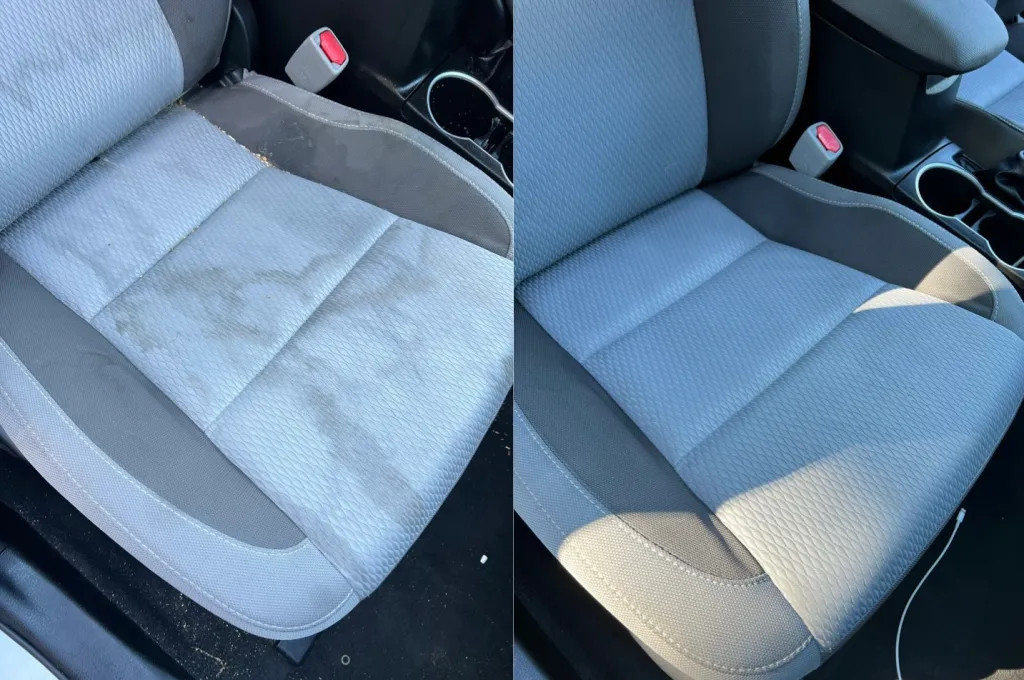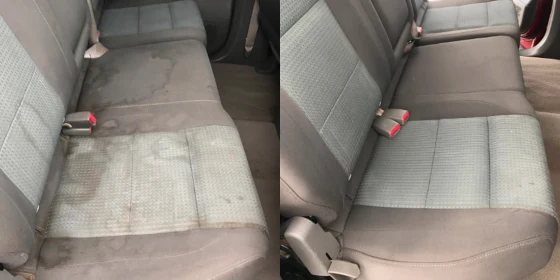Complete Guide to Interior Detailing
- rileywmdoane
- Mar 12
- 4 min read
Daily Maintenance Habits
Small, consistent actions make a significant difference:
Empty Trash Daily: Remove receipts, food wrappers, and other debris before they accumulate
Use Proper Storage: Keep designated spaces for items that must stay in your vehicle
Shake Out Floor Mats: Do this weekly to prevent dirt buildup
Wipe Down High-Touch Surfaces: Clean your steering wheel, shifter, and door handles regularly with appropriate cleaners
Odor Prevention and Elimination
Address smells at their source:
Locate and Remove Sources: Check under seats for forgotten food or spills
Carpet and Upholstery Care: Vacuum thoroughly weekly and use fabric refresher sprays
Air Circulation: Open windows periodically to allow fresh air exchange
HVAC Maintenance: Replace cabin air filters every 15,000-30,000 miles to prevent musty smells
Natural Fresheners
Skip chemical air fresheners in favor of these natural alternatives:
Activated Charcoal Bags: Place under seats to absorb odors without adding fragrance
Essential Oils: Add a few drops to a wooden clothespin attached to your vent
Baking Soda: Sprinkle on carpets before vacuuming to neutralize odors
Fresh Coffee Grounds: Place a small container under the seat for a natural, pleasant scent

Best Ways to Remove Stubborn Stains from Car Seats & Carpets
Common Stains and Solutions
Food and Beverage Stains
Coffee/Soda: Blot immediately with clean cloth, then treat with mixture of vinegar and warm water
Grease: Apply cornstarch to absorb oil, then vacuum and treat with fabric cleaner
Chocolate: Allow to harden, scrape off excess, then treat with enzyme cleaner
Organic Stains
Pet Accidents: Blot with paper towels, then use enzymatic cleaner designed for biological stains
Blood: Use cold water (never hot) and hydrogen peroxide for stubborn spots
Vomit: Remove solid material, neutralize with baking soda, then clean with enzymatic cleaner
Ink and Dye Stains
Pen Ink: Dab with isopropyl alcohol using a cotton swab, working from outside in
Makeup: Use makeup remover wipes first, then treat with appropriate upholstery cleaner
Hair Dye: Professional help recommended, but try hydrogen peroxide on light-colored upholstery
Extraction Techniques
For deep-set stains:
Steam Cleaning: Penetrates fibers to lift embedded dirt
Hot Water Extraction: Professional-grade equipment for thorough cleaning
Spot Extractors: Portable devices for immediate spill response
Leather vs. Fabric Seats: How to Clean and Protect Each
Leather Seat Care
Cleaning Process
Regular Maintenance: Wipe down with slightly damp microfiber cloth weekly
Deep Cleaning: Use pH-balanced leather cleaner quarterly
Avoid Common Mistakes: Never use household cleaners, wipes containing alcohol, or excessive water
Protection Requirements
Conditioning: Apply quality leather conditioner every 1-3 months
UV Protection: Park in shade or use window tint/sunshades to prevent drying and cracking
Perforated Leather Special Care: Use less product and avoid saturation into perforations
Fabric Seat Care
Cleaning Process
Regular Maintenance: Vacuum weekly with upholstery attachment
Spot Cleaning: Address spills immediately with appropriate cleaners
Deep Cleaning: Shampoo or steam clean twice yearly
Protection Options
Fabric Guards: Apply water and stain repellents designed for automotive upholstery
Seat Covers: Consider removable, washable covers for high-use vehicles
Preventative Measures: Establish no-food rules or designate specific eating areas
Microfiber and Alcantara
Special materials require specific care:
Microfiber: Clean with microfiber-specific cleaner and soft brush
Alcantara: Use minimal moisture and dedicated Alcantara cleaners
Synthetic Suede: Clean with light foam cleaner and soft brush in one direction
The Dangers of a Dirty Cabin: Why Interior Detailing Matters
Health Concerns
Allergen Accumulation
Dust Mites: Thrive in upholstery and can trigger allergic reactions
Mold/Mildew: Develops in damp carpets and can cause respiratory issues
Pollen: Collects on surfaces and recirculates through ventilation
Bacterial Growth
High-Touch Surfaces: Steering wheel, door handles, and controls can harbor more bacteria than a public toilet
Food Particles: Create environments for bacterial and fungal growth
Ventilation System: Can distribute contaminants throughout the cabin
Safety Implications
Visibility Issues
Dirty Windows: Reduce visibility, especially at night or in rain
Dashboard Glare: Dust accumulation can create dangerous glare
Control Functionality: Sticky or dirty controls can impede proper operation
Distraction Factors
Loose Items: Can become projectiles during sudden stops
Unpleasant Odors: Can cause driver distraction or discomfort
Allergic Reactions: Sneezing and eye irritation can momentarily divert attention
Value Preservation
Material Degradation
Premature Wear: Dirt particles act as abrasives on upholstery
UV Damage: Uncleaned surfaces degrade faster from sun exposure
System Deterioration: Dust and dirt can affect mechanical components of seats, windows, and controls
Resale Considerations
First Impressions: Interior condition strongly influences buyer perception
Odor Impact: Persistent smells can significantly decrease value
Documentation: Regular interior detailing history increases confidence for potential buyers
Health symptoms associated with dirty car interiors
Allergic reactions: Dust, pollen, and mold buildup can trigger sneezing, itchy eyes, and respiratory issues.
Asthma flare-ups: Dirty air vents and upholstery can worsen asthma symptoms due to trapped allergens and pollutants.
Skin irritation: Contact with dirty surfaces or bacteria-laden materials can lead to rashes or other skin issues.
Headaches: Poor air quality from accumulated dust and debris can contribute to frequent headaches or migraines.
Fatigue: Breathing in airborne contaminants from a dirty interior can cause tiredness or difficulty concentrating.
Regular interior detailing isn't just about aesthetics—it's an essential practice for maintaining your vehicle's value, ensuring a healthy environment, and even improving driving safety. By implementing the techniques covered in this guide, you'll create a cabin space that remains fresh, clean, and inviting for both you and your passengers for years to come.









Comments